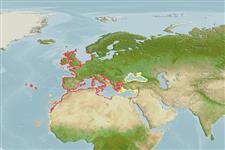Common names from other countries
Environment: milieu / climate zone / depth range / distribution range
Ecologia
marinhas; Água doce; estuarina demersal; anfídromo (Ref. 46888); intervalo de profundidade 0 - 15 m (Ref. 45332). Subtropical; 8°C - 24°C (Ref. 4944); 60°N - 12°N, 32°W - 42°E
Eastern Atlantic: western Scotland to Senegal. Also known from the Mediterranean and Black Sea. Indian Ocean: as lessepsian migrant in the Gulf of Eilat and Red Sea (Ref. 5299). Records from Pointe Noire and vicinity might be doubtful.
Comprimento de primeira maturação / Tamanho / Peso / Idade
Maturity: Lm 6.5, range 6 - 7 cm
Max length : 13.0 cm TL macho/indeterminado; (Ref. 49698); idade máx. registrada: 10 anos (Ref. 35388)
Neck naked. No black spots in the front end of each dorsal fin (Ref. 35388).
Predominantly marine, but may enter freshwater. Adults occur inshore in intertidal waters, under stones and in pools on sheltered rocky shores with much weed cover. Macrobenthos feeder on hard substrates (Ref. 92840), they feed on crustaceans (larger amphipods, isopods, small crabs) and polychaetes; juveniles eat harpacticoid copepods, amphipods, polychaetes and mites (Ref. 4696). Oviparous (Ref. 205). Fusiform shaped eggs are found in patches of several thousand on undersurface of stones, shells, polychaete tubes or Ciona mantles (Ref. 4696).
Oviparous (Ref. 205). Male guards the eggs deposited by the female under rocks or inside empty bivalve shells until they hatch (Ref. 45332). Larvae remain near the substrate until they assume the cryptobenthic behavior of the adults (Ref. 45332). Are repeat spawners (Ref. 4696).
Maugé, L.A., 1986. Gobiidae. p. 358-388. In J. Daget, J.-P. Gosse and D.F.E. Thys van den Audenaerde (eds.) Check-list of the freshwater fishes of Africa (CLOFFA). ISNB, Brussels; MRAC, Tervuren; and ORSTOM, Paris. Vol. 2. (Ref. 4343)
Status na Lista Vermelha da UICN (Ref. 130435)
CITES (Ref. 128078)
Not Evaluated
Ameaça para os humanos
Harmless
Uso pelos humanos
Pescarias: pouco comercial; Aquário: Aquários públicos
Ferramentas
Relatórios especiais
Baixar XML
Fontes da internet
Estimates based on models
Preferred temperature (Ref.
115969): 9.8 - 20.2, mean 17.7 (based on 823 cells).
Índice de diversidade filogenética (Ref.
82804): PD
50 = 0.5000 [Uniqueness, from 0.5 = low to 2.0 = high].
Bayesian length-weight: a=0.00871 (0.00672 - 0.01128), b=3.10 (3.06 - 3.14), in cm Total Length, based on LWR estimates for this species (Ref.
93245).
Nível Trófico (Ref.
69278): 3.3 ±0.45 se; based on food items.
Resiliência (Ref.
120179): médio(a), tempo mínimo de duplicação da população 1,4 - 4,4 anos (K=0.41; tm=0-3; tmax=10; Fec=1,054).
Fishing Vulnerability (Ref.
59153): Low vulnerability (19 of 100).
